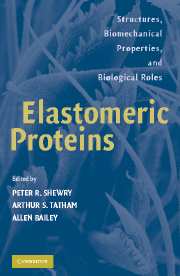Book contents
- Frontmatter
- Contents
- Preface
- Contributors
- Elastomeric Proteins
- 1 Functions of Elastomeric Proteins in Animals
- 2 Elastic Proteins: Biological Roles and Mechanical Properties
- 3 Elastin as a Self-Assembling Biomaterial
- 4 Ideal Protein Elasticity: The Elastin Models
- 5 Fibrillin: From Microfibril Assembly to Biomechanical Function
- 6 Spinning an Elastic Ribbon of Spider Silk
- 7 Sequences, Structures, and Properties of Spider Silks
- 8 The Nature of Some Spiders' Silks
- 9 Collagen: Hierarchical Structure and Viscoelastic Properties of Tendon
- 10 Collagens with Elastin- and Silk-like Domains
- 11 Conformational Compliance of Spectrins in Membrane Deformation, Morphogenesis, and Signalling
- 12 Giant Protein Titin: Structural and Functional Aspects
- 13 Structure and Function of Resilin
- 14 Gluten, the Elastomeric Protein of Wheat Seeds
- 15 Biological Liquid Crystal Elastomers
- 16 Restraining Cross-Links in Elastomeric Proteins
- 17 Comparative Structures and Properties of Elastic Proteins
- 18 Mechanical Applications of Elastomeric Proteins – A Biomimetic Approach
- 19 Biomimetics of Elastomeric Proteins in Medicine
- Index
6 - Spinning an Elastic Ribbon of Spider Silk
Published online by Cambridge University Press: 13 August 2009
- Frontmatter
- Contents
- Preface
- Contributors
- Elastomeric Proteins
- 1 Functions of Elastomeric Proteins in Animals
- 2 Elastic Proteins: Biological Roles and Mechanical Properties
- 3 Elastin as a Self-Assembling Biomaterial
- 4 Ideal Protein Elasticity: The Elastin Models
- 5 Fibrillin: From Microfibril Assembly to Biomechanical Function
- 6 Spinning an Elastic Ribbon of Spider Silk
- 7 Sequences, Structures, and Properties of Spider Silks
- 8 The Nature of Some Spiders' Silks
- 9 Collagen: Hierarchical Structure and Viscoelastic Properties of Tendon
- 10 Collagens with Elastin- and Silk-like Domains
- 11 Conformational Compliance of Spectrins in Membrane Deformation, Morphogenesis, and Signalling
- 12 Giant Protein Titin: Structural and Functional Aspects
- 13 Structure and Function of Resilin
- 14 Gluten, the Elastomeric Protein of Wheat Seeds
- 15 Biological Liquid Crystal Elastomers
- 16 Restraining Cross-Links in Elastomeric Proteins
- 17 Comparative Structures and Properties of Elastic Proteins
- 18 Mechanical Applications of Elastomeric Proteins – A Biomimetic Approach
- 19 Biomimetics of Elastomeric Proteins in Medicine
- Index
Summary
INTRODUCTION
Spider silks show a remarkable range of mechanical properties (Madsen et al., 1999; Vollrath et al., 2001), with dragline silks in some species of orb web spider exhibiting elastomeric properties when wet and quite exceptional toughness either wet or dry (Gosline et al., 1986; Vollrath and Edmonds, 1989). The wide range of mechanical behaviour results from adapted design over an evolutionary time-span of circa 400 Mio years (Shear et al., 1989) in both the spinning solution (protein dope) and the spinning conditions (Vollrath and Knight, 2001). Recent studies are beginning to use sequence information of the spidroin dopes to reconstruct phylogenetic trees of silk sequence evolution (e.g., Gatesy et al., 2001). We have now begun a comparative study of silk gland evolution. And, if all goes well, the two trees should overlap, although both sides are still a long way away from this. For such a comparative study of spinneret evolution, the Brown Recluse spider Loxosceles sp. is of particular interest because, firstly, it is not closely related (Hormiga et al., 2000) to the orb-weaving spiders most studied for their silk and glands. And, secondly, its major silk is an extremely thin ribbon (Stern and Kullmann, 1975). The extrusion of a broad ribbon instead of a cylindrical thread suggested that the mechanism of formation must be different from that used to form the dragline threads in orb web spiders.
- Type
- Chapter
- Information
- Elastomeric ProteinsStructures, Biomechanical Properties, and Biological Roles, pp. 115 - 135Publisher: Cambridge University PressPrint publication year: 2003

